
June is the first month of winter in New Zealand, and while winters here aren’t as extreme as in some parts of North America or Europe, they can still get quite cold. The North Island in particular also gets a lot of rain in the winter, but further south, in the mountains, this manifests as snow—marking the start of the ski season! Here a few important things to know about traveling to New Zealand in June.
## Weather in New Zealand During June
June in New Zealand signals the arrival of winter. Across the country, this translates to distinct weather patterns. The northern regions experience a blend of rainfall and cooler temperatures, while the southern regions encounter colder temperatures, especially along the coastlines. Although snowfall at sea level is infrequent, the mountainous areas of the South Island transform into winter wonderlands with blankets of snow.
Northland, often celebrated as the ‘winterless north,’ enjoys a subtropical climate that keeps temperatures relatively warmer compared to the rest of the nation. Daytime highs in Northland can still reach a pleasant 59° F (15° C) even during the winter months. However, Northland, along with Auckland and other parts of the upper North Island, receives significant rainfall between June and August. Whether you consider Northland truly “winterless” depends on your personal interpretation of what constitutes winter weather. The rain can be persistent, and while the temperatures are milder, the dampness can make it feel cooler than the thermometer suggests.
Generally speaking, as you journey southward through New Zealand, the winter temperatures progressively decrease. However, the Nelson, Tasman, and Marlborough regions, situated at the northern tip of the South Island, are renowned for their abundant sunshine. Nelson regularly claims the title of the sunniest place in New Zealand. While winter temperatures in this area are cool, the prevalence of sunshine makes the ‘top of the south’ a particularly appealing destination during the winter season. The clear, crisp air and bright sunny days offer a refreshing contrast to the wetter conditions further north.
Further south, temperatures continue to decline. Maximum temperatures in Wellington and Christchurch typically hover around 53° F (12° C). Given that these cities are located on the coast, inland areas tend to experience even colder conditions. Queenstown records maximum highs of 50° F (10° C), but the actual feel can be significantly colder, particularly when winds sweep down from the surrounding snow-capped mountains. The chill factor in Queenstown can be quite intense, so packing warm layers is essential.
## Crowd Levels and Travel Costs in June
June falls within the low tourism season for many parts of New Zealand. However, it also marks the beginning of the ski season in the mountainous regions, leading to increased activity in certain areas. Skiing opportunities in the North Island are primarily concentrated around the Tongariro National Park region. The South Island boasts numerous ski fields that attract enthusiasts from across the country and beyond.
Many New Zealanders are avid skiers, so expect to encounter a significant number of domestic tourists at popular ski destinations. Those less inclined towards skiing often opt for winter vacations in the Pacific Islands. Overall, June generally represents a quieter period in the North Island, while the South Island experiences greater activity due to the ski season. Consequently, accommodation and vehicle rental costs tend to reflect these trends, with prices increasing in the south and potentially decreasing in the north. Booking accommodations and rental cars in advance, especially in popular ski areas, is always recommended.
## Destination Recommendations for June
If you have a limited tolerance for overcast skies and damp weather, it is advisable to exercise caution when planning trips to most of the North Island during June. While there are undoubtedly beautiful sights to behold and occasional spells of pleasant weather, the North Island is generally not at its prime during this time of year. It is still possible to enjoy indoor attractions and city sightseeing in Auckland and Wellington. The same caution applies to coastal regions in the lower South Island, such as Dunedin and Invercargill.
The South Island, however, presents an enticing proposition for skiers, snowboarders, and anyone captivated by snow-dusted mountain landscapes. Be aware that mountain roads can be temporarily impassable due to heavy snowfall. If you intend to embark on a self-driving adventure across the country, it is crucial to stay informed about local conditions before attempting to traverse any high mountain passes. Checking weather forecasts and road closures is essential for a safe and enjoyable journey.
As previously mentioned, the ‘top of the south’ regions enjoy relatively mild winter conditions. A warm jacket is a necessity, but Nelson, the Abel Tasman National Park, the Marlborough Sounds, and Golden Bay offer a particularly agreeable experience during the winter months. The combination of sunshine, stunning scenery, and fewer crowds makes this region a great choice for a June getaway.
## Activities to Consider
June provides a great opportunity to partake in general sightseeing activities that seamlessly blend indoor and outdoor experiences. The major cities of Auckland, Wellington, Christchurch, and Dunedin offer an array of exceptional museums, galleries, and cultural attractions. Elsewhere in the country, you can find engaging activities such as Maori cultural performances in Rotorua and Taupo, dolphin and whale-watching tours in the Bay of Islands and Kaikoura, scenic cruises in Milford Sound and Doubtful Sound, and wildlife viewing expeditions on the Otago Peninsula. Renting a car or RV offers the flexibility to modify your plans in response to the ever-changing weather conditions.
June is less suited to long-distance treks due to the prevailing cold and damp conditions. However, experienced and well-prepared hikers can still find rewarding trails to explore. It is advisable to stick to lower elevations, such as the Abel Tasman National Park, unless you possess advanced alpine and snow skills. Unfortunately, some international visitors underestimate the challenging nature of winter conditions in areas such as the Tongariro National Park or the Routeburn Track in Fiordland. Alternatively, maintaining a flexible itinerary allows you to take advantage of any opportunities for day hikes when the weather permits.
## June Events in New Zealand
**Queenstown Winter Festival:** Queenstown revolves around skiing, so the town embraces winter with the Queenstown Winter Festival. You can enjoy free concerts and snow sports events, celebrating the start of the ski season.
## Suggested New Zealand Itineraries for June
South Island Highlights and New Zealand Wines – 12 Days: This itinerary leads you through New Zealand’s beautiful South Island, where you will get to experience its cultural hotspots, famous landscapes and public gardens, and sprawling vineyards.
South Island Tour: Christchurch, Akaroa, and Hanmer Springs – 5 Days: This quick, five-day trip showcases the best of New Zealand’s South Island. Explore the culture of Christchurch, experience the coastal beauty of Akaroa, and relax in the natural hot springs at Hanmer Springs.
Best of New Zealand’s South Island – 10 Days: This 10-day road trip in the South Island combines the best of New Zealand. See sights such as Lake Tekapo, Aoraki Mt. Cook and the surrounding glaciers, the peaks of Mt. Aspiring National Park, and the magnificent fiords.
B-1839

